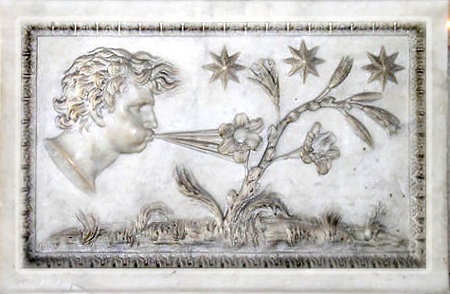John Keats, selected poems Contents
On the Sea: Imagery, symbolism and themes
Imagery and symbolism in On the Sea
The images of Hecate and sea-nymphs associates the sea with the mythic and the mysterious, aided by mentions of ‘Caverns’ and ‘Shadowy sound’.
 The sea and shore are animated. The sound of the waves constitute ‘eternal whisperings’ around ‘desolate’ shores. The sea undergoes rapid changes of mood, sometimes capable of ‘gentle temper’. The winds are similarly animated through their association with the myth of Aeolus, god of the winds. The effect of all this animation is to endow the sea and the elements with almost a personal force and increases the sense of power and mystery.
The sea and shore are animated. The sound of the waves constitute ‘eternal whisperings’ around ‘desolate’ shores. The sea undergoes rapid changes of mood, sometimes capable of ‘gentle temper’. The winds are similarly animated through their association with the myth of Aeolus, god of the winds. The effect of all this animation is to endow the sea and the elements with almost a personal force and increases the sense of power and mystery.The changing mood-swings of the sea are captured by dwelling on the contrast between its vast expanse and the ‘very smallest shell’ which the sea can leave in place for days, if in the mood to do so.
Investigating imagery and symbolism in On the Sea
- How does the mythological imagery help to create the sonnet’s air of mystery?
- Find examples of personification. What is their effect?
- Why does Keats concentrate on the sea’s ‘mood-swings’ rather than take a more scientific approach to the different states of the sea?
Themes in On the Sea
As so often in his poems, Keats is fascinated by things which appear eternal and contrasts them with the ephemeral affairs of mankind.
An obvious theme is the power of nature – and its dynamic range. The sea is capable both of ‘mighty swell’ and of leaving the ‘very smallest shell’ undisturbed. It is this range which is part of the mystery – and also part of the sea’s ability to strike awe and fear into human beings. Its mood-swings are unpredictable and the transition between calm and storm can be rapid and devastating.
Another theme is that of the sea’s therapeutic effect on city-bound human beings. There is something so primeval about the sounds of the sea that they have a revitalising effect on those who sit and listen to it.
Investigating themes in On the Sea
- In this sonnet the natural world is seen as providing food for the soul. In what other Keats’ poems does this theme appear?
- Look particularly at the Ode to Melancholy.
- How obvious are the themes of this poem?
- Is it perhaps truer to say that Keats presents his readers with an image of the sea and some of its mythological associations and leaves it to them to make of it what they please?
- To what extent is the contrast between the infinite and the temporal part of the poem’s thematic core?
Recently Viewed
-
John Keats, selected poems » On the Sea: Imagery, symbolism and themes
now -
John Keats, selected poems » Ode to Melancholy: Imagery, symbolism and themes
just now -
John Keats, selected poems » Romantic beliefs
just now -
John Keats, selected poems » Life’s brevity versus art’s permanence
just now -
John Keats, selected poems » To Leigh Hunt: Language, tone and structure
just now -
John Keats, selected poems » Ode to a Nightingale: Language, tone and structure
just now -
John Keats, selected poems » Bright Star! - Language, tone and structure
just now -
A-Z: General definitions » King Lear
just now -
John Keats, selected poems » Paradoxical life
just now -
John Keats, selected poems » O Solitude, if I must with thee dwell: Synopsis and commentary
just now -
John Keats, selected poems » The Eve of St Agnes - Synopsis and commentary
just now -
John Keats, selected poems » To Mrs Reynolds’s Cat: Synopsis and commentary
just now -
John Keats, selected poems » Keats’ literary career
just now -
A-Z: General definitions » Cupid
just now -
John Keats, selected poems » To Mrs Reynolds’s Cat: Language, tone and structure
just now -
John Keats, selected poems » Ode to Psyche: Language, tone and structure
just now -
John Keats, selected poems » Ode on Indolence: Language, tone and structure
just now -
John Keats, selected poems » Lamia: Language, tone and structure
just now -
John Keats, selected poems » The Eve of St Agnes - Language, tone and structure
just now -
A-Z: General definitions » Theologian
just now -
John Keats, selected poems » On Seeing the Elgin Marbles: Language, tone and structure
just now -
John Keats, selected poems » Revolution and war
just now
